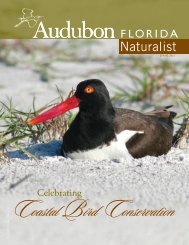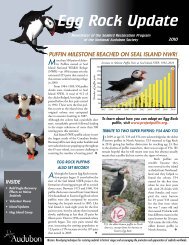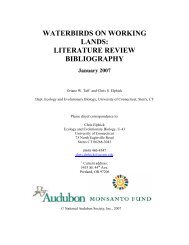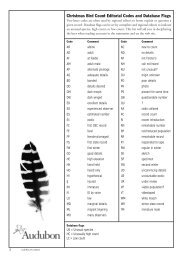Full report [PDF] - the Boreal Songbird Initiative
Full report [PDF] - the Boreal Songbird Initiative
Full report [PDF] - the Boreal Songbird Initiative
Create successful ePaper yourself
Turn your PDF publications into a flip-book with our unique Google optimized e-Paper software.
Table 5. Species in which <strong>the</strong> area of North America’s <strong>Boreal</strong> Forest Region occupiedduring migration exceeds <strong>the</strong> area occupied during breeding or wintering (29 species).Greater White-fronted GooseSnow GooseRoss’s GooseBrantCackling GooseTundra SwanGadwallRough-legged HawkWhooping CraneBlack-bellied PloverAmerican Golden-PloverPacific Golden-PloverSemipalmated PloverHudsonian GodwitRed KnotSanderlingSemipalmated SandpiperWhite-rumped SandpiperBaird’s SandpiperPectoral SandpiperDunlinStilt SandpiperBuff-breasted SandpiperLong-billed DowitcherAmerican PipitHarris’s SparrowLapland LongspurSmith’s LongspurSnow Buntingexample, <strong>the</strong> White-rumped Sandpiper does not breed in <strong>the</strong> <strong>Boreal</strong> Forest Regionbut makes extensive use of wetlands within <strong>the</strong> <strong>Boreal</strong> Forest Region during its falland spring migration. O<strong>the</strong>r shorebirds, like <strong>the</strong> Pectoral Sandpiper, which haveinsignificant portions of <strong>the</strong> breeding range in <strong>the</strong> <strong>Boreal</strong> zone, are also highly relianton <strong>Boreal</strong> Forest Region wetlands during migration. Waterfowl, like <strong>the</strong> GreaterWhite-fronted Goose, Snow Goose, Cackling Goose, Tundra Swan, and GreaterScaup, also regularly migrate through a large part of <strong>the</strong> <strong>Boreal</strong> Forest Region. Notquantified here is use of <strong>the</strong> <strong>Boreal</strong> Forest Region by “molt-migrants,” birds thatmigrate north into <strong>the</strong> <strong>Boreal</strong> Forest Region after breeding to undergo molt, a practicecommon among many waterfowl species.Green-winged TealPhoto © Ducks Unlimited CanadaWhere do birds that breed in North America’s <strong>Boreal</strong> Forest Region spend <strong>the</strong> winter?Approximately 94 percent of individual birds migrate out of <strong>the</strong> <strong>Boreal</strong> ForestRegion after breeding, judging by migratory shifts in range between breeding andwintering grounds. These <strong>Boreal</strong> migrants winter in many countries throughout <strong>the</strong>Western Hemisphere, with several species wintering outside of <strong>the</strong> hemisphere. Morespecies winter in <strong>the</strong> United States (lower 48) than in any o<strong>the</strong>r country or region—a total of 204 species or approximately 63 percent of <strong>Boreal</strong> Forest Region breedingbirds (Table 6). Mexico is a close second in importance, with 190 species (59 percent),followed by Central America (115 species, 36 percent), South America (87species, 27 percent) and <strong>the</strong> Caribbean (86 species, 27 percent). If species with lessthan 10 percent of <strong>the</strong>ir breeding range in <strong>the</strong> <strong>Boreal</strong> Forest Region are excluded, <strong>the</strong>number of migrant species wintering in all of <strong>the</strong>se regions is still high, ranging from59 species wintering in South America, to 137 in <strong>the</strong> United States (Table 6).Several of <strong>the</strong>se species winter largely in a single country or region. AmericanBlack Ducks, Yellow Rails, Rusty Blackbirds, Smith’s Longspurs, Harris’s Sparrows,and Golden-crowned Sparrows are among species in which virtually <strong>the</strong> entire winteringpopulation occurs only within <strong>the</strong> United States. Virtually all Cape MayWarblers winter in <strong>the</strong> Caribbean. Most Baird’s Sparrows winter in Mexico, whileYellow-bellied Flycatchers, Philadelphia Vireos, Wilson’s Warblers, and MagnoliaWarblers are restricted in winter to Mexico and Central America. Birds like <strong>the</strong>Table 6. Number of species of boreal migrants by wintering region (excluding species with1% breed in <strong>Boreal</strong> Forest Region 204 190 115 86 87>10% breed in <strong>Boreal</strong> Forest Region 137 128 81 65 59THE 105TH CHRISTMAS BIRD COUNT AMERICAN BIRDS 35


![Full report [PDF] - the Boreal Songbird Initiative](https://img.yumpu.com/52893853/8/500x640/full-report-pdf-the-boreal-songbird-initiative.jpg)







